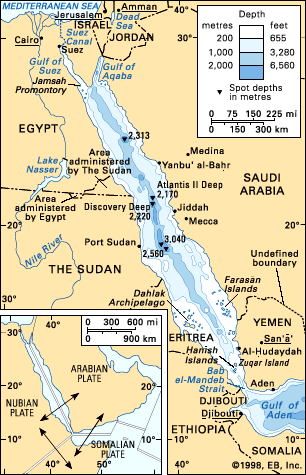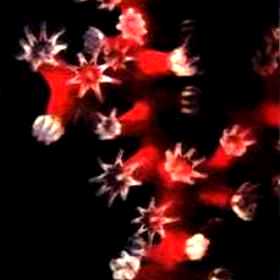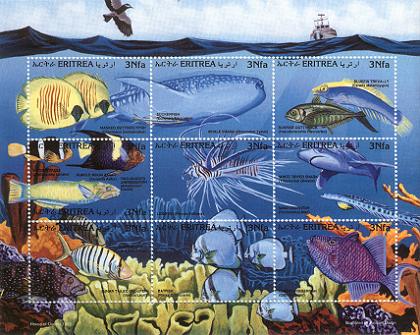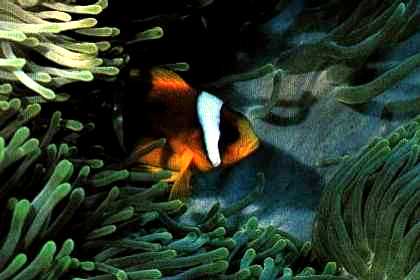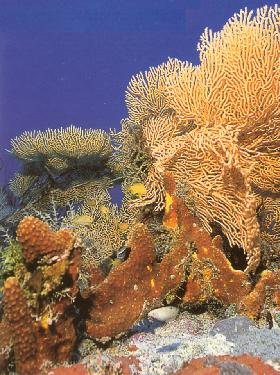Map of Eritrea
Location and geography
Eritrean history
Border conflict with Ethiopia
Political structure
Eritrean anthem
Economy & currency
Climate
People
Languages
Religion
Health care
Transport
Cuisine
News, links, books and more
Asmara (Asmera)
Agordat (Akordat)
Assab (Asseb)
Barentu
Dahlak islands
Dekemhare (Decemhare)
Ghinda (Ginda)
Keren (Cheren)
Massawa (Massauwa)
Mendefera (Adi Ugri)
Nakfa (Nacfa)
Semenawi Bahri (Filfil)
Tessenei
(Teseney)
The Red Sea
Geographically, the Red Sea and the Arabian Gulf areas have only recently become seas. The Red Sea occupies a portion of a zone of depression and faulting called the Great Rift Valley. The Red Sea was created by the movement of plates in the Earth's surface about 30 million years ago. In that time, the Arab peninsula started to part from Africa along a thin break line which was filled by the ocean's water. Twenty million years ago another geological movement started. The Arab peninsula which parted from Africa, started to move to the north. (see Plate Tectonics). That movement struck resistance in Turkey and swung to the east, and another break line was formed. This one stretching all the way from the northern part of Israel, through the Jordan valley to the Dead Sea, and finally through the Gulf of Eilat to Ras Mohamad at the southern point of the Sinai. Hydrothermal vents on the seafloor are evidence of ongoing tectonic activity. The Red Sea is still widening at about one-half inch per year.
On this map the evidence is clear that eons ago the
Arabian Peninsula and Africa formed one land mass.
The waters of the Gulf of Aden and the Red Sea have
filled the gap formed when the continents separated.
The Red Sea is 2,350 kilometers in length and reaches its maximum width of 350 kilometers at the Eritrean coast. With the opening of the Suez Canal, in 1869, connecting the Red Sea with the Mediterranean Sea, The Red Sea increased both in strategic and economical importance, making possible a comparatively direct sea route between Europe and The Far East. The principal Red Sea ports include Suez and Al Qusayr in Egypt, Port Sudan and Sawakin in Sudan, Massawa and Assab in Eritrea, Jeddah in Saudi Arabia, and Al Hudaydah and Mocha (Al Mukha) in Yemen.
The Red Sea is perhaps the most extraordinary large body of water on earth. It is an enormous basin locked in the north by the Suez Canal and in the south by the Strait of Bab al Mandeb, just 300 feet deep, thereby clearly cut off from the currents of the Indian Ocean and Mediterranean Sea, resulting in the elimination of the tidal system.
Each polyp of the red sea fan is an individual animal that opens for feeding.
The colony creates the branching skeletal casing upon which they reside.
The Red Sea has a higher salinity than any ocean (ranging from 39 parts per 1,000 at the southern end up to 41 parts per 1,000 at the Gulf of Suez, versus a more 'normal' 36 parts per thousand. No rivers run into it. Scorched by tropical sun and seared by desert drought - annual rainfall averages less than an inch - it loses each year through evaporation the equivalent of about six feet of water. To replace this huge deficit, water flows in chiefly from the Indian Ocean through shallow Bab al Mandab, the strait at the southern end.
Most ocean depths are cold, but the Red Sea holds warm abyssal water, especially in certain volcanic depths where temperatures reach 138° Fahrenheit. These hot spots hoard potential fortunes of immeasurable worth: in places 5,000 times more iron, 25,000 times more manganese, and 30,000 times more lead then normal seawater. And the value of the gold, silver, copper, and zinc in the upper 30 - of a possible 300 - feet of sediments alone has been estimated at more than two billion dollars.
Series of stamps issued by the Eritrean Postal Services, dedicated to the
fauna of the Eritrean Dahlak Islands, famous for their diving opportunities.
The Red Sea is the world's last great unspoiled tropical paradise, where every scuba diver or snorkeller has something to explore. The Red Sea is one of the richest areas in the world. There are over 1,000 species of fish, 2,000 species of invertebrates, and 180 species of corals. Many of these species are indigenous to the Red Sea. Among the corals and anemones you can spot tough-beaked parrotfish, big-eyed squirrel fish, disc-shaped surgeon fish and countless other species. There are manta rays with wing spans of many meters, and there are the famous Red Sea sharks. Despite their reputation, however, shark attacks on swimmers in the area are very rare. Giant sea turtles lay their eggs on the sandy beaches. Pods of dolphins can appear to play around the boat, and even giant dugongs or sea cows are sometimes seen. And there are seabirds - sterns, seagulls, sand plovers, herons, pelicans.
The Indian Ocean, though the sea's southern bottleneck at Bab al Mandab, has been the primordial source for most living things in its oceanic offshoot. Thus the Red Sea is a kind of special-environment incubator for the evolution of immigrant Indian Ocean species. Some scientists believe the number of fish species unique to the Red Sea runs as high as 15 percent of the total found there. For most, the pedigree can be traced back to a cousin in the Indian Ocean. In 1989 international experts and scientists picked the Red Sea as one of the seven underwater wonders of the world, offering a diverse multitude of reefs, wall, wrecks and abundant marine life.
The Red Sea is one of the world's most celebrated diving locations,
boasting an amazing variety of coral and fish life in clear waters.
The Red Sea takes its name from the seasonal abundance of cyanobacteria Trichodesmium Erythraceum, minute algae, that have a brownish-red pigment. These algae, which live near the surface of the sea, bloom at certain times of the year, the "red tide". They appear like groups of red and pinkish blankets on the surface of the water. After the bloom, the algae die, and they turn the sea reddish-brown.
Weeks can go by with hardly a puff of wind over the sea. The calm surface catches fire at sunrise and sunset, reflecting rosy heavens and the glowing pink hills that border this sea. Author E.M. Forster stated that the "exquisite corridor of tinted mountains and radiant water" was named Mare Rostrum (Latin for Red Sea) by early travelers because of the region's reddish mineral-rich mountains.
Spectacular coral gardens in the Red Sea.
Scattered across the Red Sea like pearls upon a string, Eritrea's more than 350 islands have been described as the world's last unspoiled tropical paradise. The Eritrean Red Sea coast and islands provide opportunities for sea cruise holidays, scuba-diving, fishing and other water sports.
